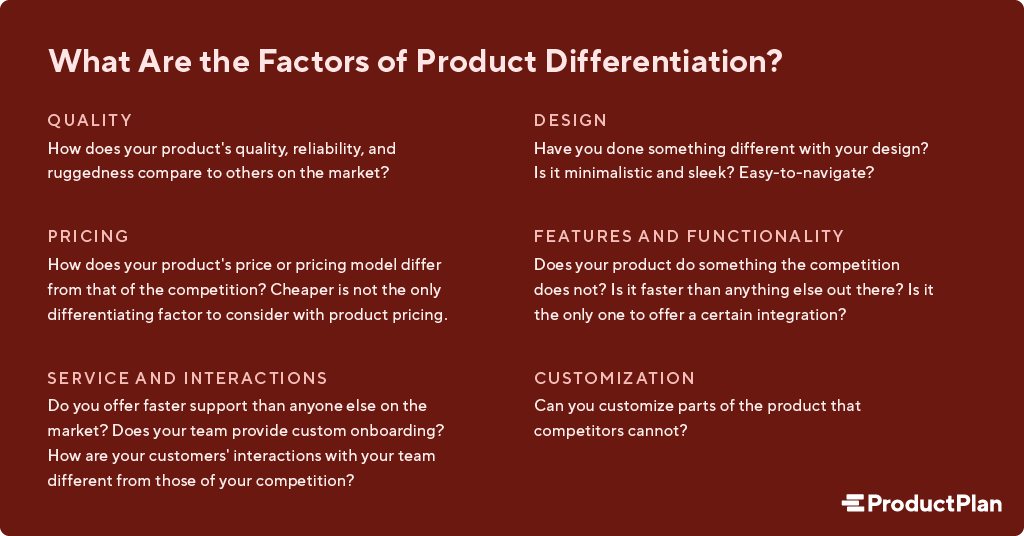What is Product Differentiation?
Product differentiation is a process used by businesses to distinguish a product or service from other similar ones available in the market.
This tactic aims to help businesses develop a competitive advantage and define compelling, unique selling propositions (USPs) that set their product apart from competitors. In addition, organizations with multiple products in their portfolio may use differentiation to separate their various products from one another and prevent cannibalization.
This article will provide an overview of product differentiation and answer several common questions about this process.
Why is Product Differentiation Important?
In many industries, the barrier to entry has dropped significantly in recent years. As a side effect, these industries have seen substantial increases in competitive products. In increasingly crowded competitive landscapes, differentiation is a critical prerequisite for a product’s survival.
What does your product or service do/accomplish/offer that the competition does not? Product differentiation helps your organization answer this question and focus on the unique value a product brings to its users. If no effort is put into a differentiation strategy, products risk blending in with a sea of competitors and never getting the market hold they need to keep going.
Who is Responsible for Product Differentiation?
While many schools of thought suggest differentiation is marketing’s responsibility, that is not necessarily true. In fact, virtually every department within an organization can play a role in product differentiation.
Which teams are responsible for differentiation?
- Marketing
- Product Management
- Engineering
- Sales
- Support and Success
This is because any aspect of your product can be a differentiating factor. We usually think first of marketing because it’s marketing that focuses on product positioning and is often the first touchpoint for a customer or prospect. However, differentiation is more than just how marketing positions the product—every single customer touchpoint is an opportunity for differentiation. For example, is the product reliable or prone to outages? How difficult is it to purchase the product? What are customer interactions with support and success like?
The answers to each of these questions could lead to a differentiating factor.
What are Types of Product Differentiation?
Several different factors can differentiate a product. However, there are three main categories of product differentiation. These include horizontal differentiation, vertical differentiation, and mixed differentiation.
Horizontal Differentiation
Horizontal differentiation refers to any differentiation that is not associated with the product’s quality or price point. Instead, these products offer the same thing at the same price point. When making decisions regarding horizontally differentiated products, it often boils down to the customer’s personal preference.
Examples of Horizontal Differentiation: Pepsi vs. Coca-Cola, bottled water brands, types of dish soap.
Vertical Differentiation
In contrast to horizontal differentiation, vertically differentiated products are extremely dependent on price. With vertically differentiated products, the price points and marks of quality are different. And, there is a general understanding that if all the options were the same price, there would be a clear winner for “the best.”
Examples of Vertical Differentiation: Branded products vs. generics, A basic black shirt from Hanes vs. a basic black shirt from a top designer, the vehicle makes.
Mixed Differentiation
Also called “simple differentiation,” mixed differentiation refers to differentiation based on a combination of factors. Often, this type of differentiation gets lumped in with horizontal differentiation.
Examples of Mixed Differentiation: Vehicles of the same class and similar price points from two different manufacturers.
What are the Factors of Product Differentiation?
Now that we’ve looked at the categories of product differentiation let’s look at the specific factors that can differentiate products. A product’s unique selling proposition (USP) can be literally anything that makes it unique or different from others out there. Here are a few examples of ways companies can differentiate their products from others in the market.

How Do You Develop a Product Differentiation Strategy?
Ready to start focusing on product differentiation but not sure where to start? Here are a few steps to get you headed in the right direction.
- Know your market. Take note of the market your product serves. Who are the competing organizations, and what do they offer? What types of key customer needs are not being met with existing options?
- Work with your entire team to establish ways you can potentially distinguish your product from others in the market. Take inventory of the benefits and values your product brings to customers and establish how important those values are.
- Identify opportunities to differentiate the product from others further. Then, assess where they may belong in your organization’s strategic product roadmap.
Our examples above have only scratched the surface on what different factors can differentiate a product. And it’s worth noting that there is no right way to approach product differentiation. The ideal process is different for every product, team, and organization.
See also: Unique Selling Proposition, Product Lifecycle
